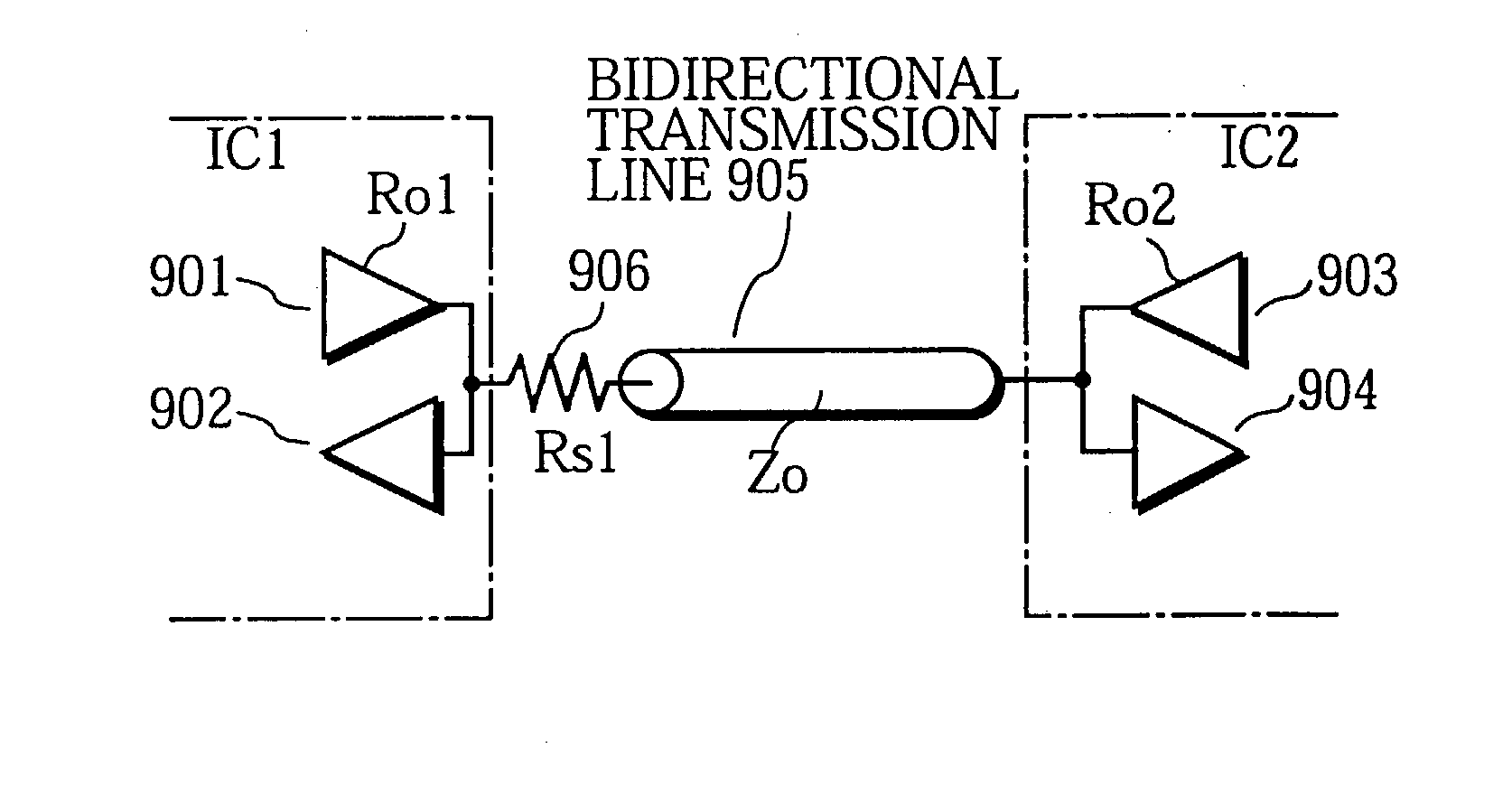Bidirectional signal transmission circuit and bus system
a transmission circuit and bus system technology, applied in the field of bidirectional signal transmission circuit and bus system, can solve the problems of data transfer rate, inconvenient operation, and difficulty in proper data transfer, and achieve the effect of fast signal transmission and facilitate impedance matching
- Summary
- Abstract
- Description
- Claims
- Application Information
AI Technical Summary
Benefits of technology
Problems solved by technology
Method used
Image
Examples
first embodiment
[0074] First Embodiment
[0075] FIG. 7 shows the construction of a bidirectional signal transmission circuit according to the first embodiment of the invention. In the figure, a bidirectional transmission line 105 is a transmission line (whose characteristic impedance is Zo) for transmitting signals in two directions. This bidirectional transmission line 105 is one of bus lines constituting a bidirectional bus, such as a data bus, which connects semiconductor devices IC1 and IC2.
[0076] An I / O (Input / Output) circuit 120 is equipped within semiconductor device IC1 for inputting / outputting signals, and is mainly made up of an output buffer 101 (whose output resistance is Ro1) and an input buffer 102.
[0077] An I / O circuit 121 is equipped within semiconductor device IC2 for inputting / outputting signals, and is mainly made up of an output buffer 103 (whose output resistance is Ro2) and an input buffer 104.
[0078] A switching unit 106 assumes either of two states, namely series termination an...
second embodiment
[0090] Second Embodiment
[0091] FIG. 9 shows the construction of a bidirectional signal transmission circuit according to the second embodiment of the invention. This bidirectional signal transmission circuit differs with that shown in FIG. 7 in that switching units 301 and 303 have replaced the switching units 106 and 110. Construction elements which are the same as those in FIG. 7 have been given the same reference numerals and their explanation has been omitted, so that the following explanation will focus on the differences with the first embodiment.
[0092] The switching units 301 and 303 are different with the switching units 106 and 110 in that they are equipped respectively with buffer amplifiers 302 and 304 for amplifying signals instead of the resistors 108 and 112.
[0093] The buffer amplifier 302 is a buffer amplifier whose output resistance is approximately equal to the impedance Zo of the bidirectional transmission line 105. Accordingly, in the output of the I / O circuit 120...
third embodiment
[0097] Third Embodiment
[0098] FIG. 10 shows the construction of a bidirectional signal transmission circuit according to the third embodiment of the invention. This bidirectional signal transmission circuit differs with that shown in FIG. 7 in that switching units 401 and 403 have replaced the switching units 106 and 110. Construction elements which are the same as those in FIG. 7 have been given the same reference numerals and their explanation has been omitted, so that the following explanation will focus on the differences with the first embodiment.
[0099] In the switching units 401 and 403, series terminating resistors 108 and 112 have different resistances from those in the switching units, 106 and 110, and buffer amplifiers 402 and 404 for amplifying signals are newly equipped.
[0100] The buffer amplifiers 402 and 404 are arranged at stages immediately preceding the respective series terminating resistors 108 and 112 (i.e. on the sides of IC1 and IC2 with respect to the resistor...
PUM
 Login to View More
Login to View More Abstract
Description
Claims
Application Information
 Login to View More
Login to View More - R&D
- Intellectual Property
- Life Sciences
- Materials
- Tech Scout
- Unparalleled Data Quality
- Higher Quality Content
- 60% Fewer Hallucinations
Browse by: Latest US Patents, China's latest patents, Technical Efficacy Thesaurus, Application Domain, Technology Topic, Popular Technical Reports.
© 2025 PatSnap. All rights reserved.Legal|Privacy policy|Modern Slavery Act Transparency Statement|Sitemap|About US| Contact US: help@patsnap.com



